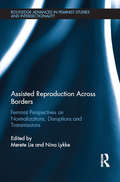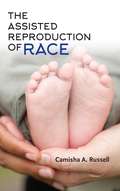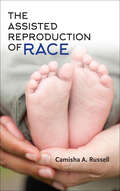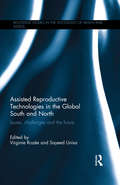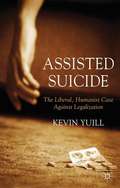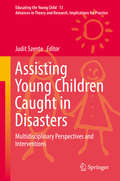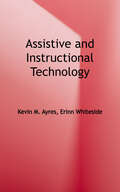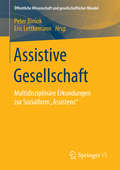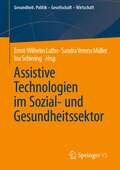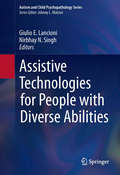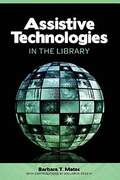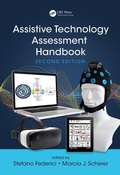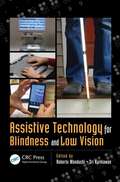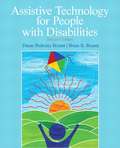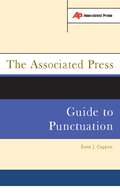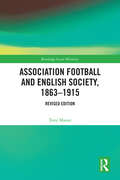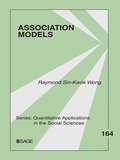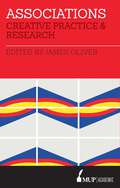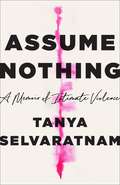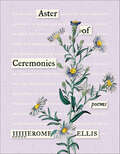- Table View
- List View
Assisted Reproduction Across Borders: Feminist Perspectives on Normalizations, Disruptions and Transmissions (Routledge Advances in Feminist Studies and Intersectionality)
by Merete Lie Nina LykkeToday, it often seems as though Assisted Reproductive Technologies (ARTs) have reached a stage of normalization, at least in some countries and among certain social groups. Apparently some practices – for example in vitro fertilization (IVF) – have become standard worldwide. The contributors to Assisted Reproduction Across Borders argue against normalization as an uncontested overall trend. This volume reflects on the state of the art of ARTs. From feminist perspectives, the contributors focus on contemporary political debates triggered by ARTs. They examine the varying ways in which ARTs are interpreted and practised in different contexts, depending on religious, moral and political approaches. Assisted Reproduction Across Borders embeds feminist analysis of ARTs across a wide variety of countries and cultural contexts, discussing controversial practices such as surrogacy from the perspective of the global South as well as the global North as well as inequalities in terms of access to IVF. This volume will appeal to scholars and students of anthropology, ethnography, philosophy, political science, history, sociology, film studies, media studies, literature, art history, area studies, and interdisciplinary areas such as gender studies, cultural studies, and postcolonial studies.
The Assisted Reproduction of Race
by Camisha A. RussellThe use of assisted reproductive technologies (ART)--in vitro fertilization, artificial insemination, and gestational surrogacy--challenges contemporary notions of what it means to be parents or families. Camisha A. Russell argues that these technologies also bring new insight to ideas and questions surrounding race. In her view, if we think of ART as medical technology, we might be surprised by the importance that people using them put on race, especially given the scientific evidence that race lacks a genetic basis. However if we think of ART as an intervention to make babies and parents, as technologies of kinship, the importance placed on race may not be so surprising after all. Thinking about race in terms of technology brings together the common academic insight that race is a social construction with the equally important insight that race is a political tool which has been and continues to be used in different contexts for a variety of ends, including social cohesion, economic exploitation, and political mastery. As Russell explores ideas about race through their role in ART, she brings together social and political views to shift debates from what race is to what race does, how it is used, and what effects it has had in the world.
The Assisted Reproduction of Race
by Camisha A. RussellA philosopher examines the social implications of assisted reproductive technologies at the intersection of race, medicine, and bioethics.The use of assisted reproductive technologies (ART)—in vitro fertilization, artificial insemination, and gestational surrogacy—challenges contemporary notions of what it means to be parents or families. Camisha A. Russell argues that these technologies also bring new insight to ideas and questions surrounding race. She does this in part by reframing ART, as medical technologies that also act as technologies of kinship.Thinking about race in terms of technology brings together the common academic insight that race is a social construction with the equally important insight that race is a political tool used in different contexts for a variety of ends. As Russell explores ideas about race through their role in ART, she brings together social and political views to shift debates from what race is to what race does, how it is used, and what effects it has had in the world.
Assisted Reproductive Technologies in the Global South and North: Issues, Challenges and the Future
by Virginie Rozée Sayeed UnisaAssisted Reproductive Technologies in the Global South and North critically analyses the political and social frameworks of Assisted Reproductive Technology (ART), and its impact in different countries. In the context of a worldwide social pressure to conceive – particularly for women – this collection explores the effect of the development of ARTs, growing globalisation and reproductive medicalization on global societies. Providing an overview of the issues surrounding ART both in the Global South and North, this book analyses ART inequalities, commonalities and specificities in various countries, regions and on the transnational scene. From a multidisciplinary perspective and drawing on multisite studies, it highlights some new issues relating to ART (e.g. egg freezing, surrogacy) and discusses some older issues regarding infertility and its medical treatment (e.g. in vitro fertilisation, childless stigmatisation and access to treatment). This book aims to redress the balance between what is known about Assisted Reproductive Technologies in the Global North, and how the issue is investigated in the Global South. It aims to draw out the global similarities in the challenges that ARTs bring between these different areas of the world. It will appeal to scholars and students in the social sciences, medicine, public health, health policy, women’s and gender studies, and demography.
Assisted Suicide The Liberal, Humanist Case against Legalization
by Kevin YuillThis book presents an atheistic case against the legalization of assisted suicide. Critical of both sides of the argument, it questions the assumptions behind the discussion. Yuill shows that our attitudes towards suicide - not euthanasia - are most important to our attitudes towards assisted suicide.
Assistiert Altern: Die Entwicklung digitaler Technologien für und mit älteren Menschen (Altern & Gesellschaft)
by Cordula EndterDigitale Assistenztechnologien sollen ältere Menschen unterstützen, auch bei altersbedingten Einschränkungen möglichst lange selbstbestimmt leben zu können. Wie aber werden diese Technologien entwickelt? Welche Vorstellungen von Alter(n) spielen dabei eine Rolle? Wie werden ältere Menschen in die Technikentwicklung eingebunden? Und welche Ziele verfolgen Politik, Technikentwickler*innen und Gesellschaft mit der Entwicklung digitaler Asssistenztechnologien? Das Buch gibt anhand einer ethnographischen Studie Antworten auf diese Fragen und zeigt auf, welche Voraussetzungen in Forschung und Entwicklung geschaffen werden müssen, damit digitale Technologien den Bedürfnissen älterer Menschen entsprechen und sie in ihrem Alltag unterstützen.
Assisting Young Children Caught in Disasters: Multidisciplinary Perspectives and Interventions (Educating the Young Child #13)
by Judit SzenteThis volume discusses 14 different types of disasters and their implications on the social, emotional and academic development of young children, from birth through age eight. It focuses on human-related crises and disasters such as community violence exposure; war and terrorism; life in military families; child trafficking; parent migration; radiation disasters; HIV/AIDS; and poverty. The environment-related disasters addressed in this book include hunger; hurricanes; earthquakes; frostbites; wildfires; and tornadoes. The volume includes suggestions for interventions, such as using picture books with young children in coping with natural disasters and human crises. In addition, each chapter provides research-based strategies for early childhood and related professionals to be used in the classroom. Many children in our world today experience some type of disasters and/or crises. These crises or disasters can either be human- or environment-related and can interrupt children's daily lives. They often negatively impact children's development, education, and safety. Bringing together authors representing a variety of countries including Australia, Canada, China, Finland, Haiti, Hungary, Kenya, USA, and Zimbabwe, this book provides truly global perspectives on the various types of disasters and their implications for our work with young children.
Assistive and Instructional Technology
by Kevin M. Ayres Erinn WhitesideAssistive and Instructional Technology is a guide to using technology in the classrooms of students with autism spectrum disorder. This book describes the difference between assistive and instructional technology and how they are related. It identifies key features to look for in new technology and provides step-by-step support for using it effectively. This succinct resource describes critical aspects of current technology that result in improved learning outcomes.
Assistive Gesellschaft: Multidisziplinäre Erkundungen zur Sozialform „Assistenz“ (Öffentliche Wissenschaft und gesellschaftlicher Wandel)
by Peter Biniok Eric LettkemannDie Beitr#65533;ge des Buches befassen sich mit der Frage, was ,Gesellschaft' bedeutet, wenn nahezu alle Lebensbereiche assistiert werden. Ob Blindenhund, Butler oder Assistent der Gesch#65533;ftsf#65533;hrung, Herzschrittmacher oder Navigationssystem, Pflegeroboter oder Ambient Assisted Living - wir werden assistiert von anderen Personen und Lebewesen, und immer h#65533;ufiger auch von Technologien und Artefakten. Diesen Assistenten kommt eine spezifische und neue Rolle zu: sie besch#65533;tzen, sie helfen, sie steuern uns. Prozesse der Assistierung in Lebens- und Arbeitswelt werden oft im Einklang mit sich steigernden Kompensations- und Effizienzversprechen vorangetrieben. Aber wie gestaltet sich Assistenz konkret? Welche Wechselwirkungen entstehen zwischen den beteiligten Instanzen? Und welche gesellschaftlichen Dynamiken und unbeabsichtigten Folgen sind damit verbunden? Darauf versucht der Sammelband Antworten zu geben.
Assistive Technologien im Sozial- und Gesundheitssektor (Gesundheit. Politik - Gesellschaft - Wirtschaft)
by Sandra Verena Müller Ernst-Wilhelm Luthe Ina SchieringInwiefern kann die Verwendung assistiver Technologien im Sozial- und Gesundheitssektor eine Antwort sein auf drängende Fragen des demografischen Wandels, des sektoralen Fachkräftemangels und der gesellschaftlichen Teilhabe vulnerabler Personen? Sind sie ein wünschenswerter Beitrag zur Selbstbestimmung und Erhöhung der Versorgungssicherheit der Bevölkerung oder eine fatale Entwicklung hin zu einer Ökonomisierung unserer Hilfesysteme? Das Buch nimmt hierzu Stellung aus unterschiedlichen Richtungen: medizinisch, psychologisch, ökonomisch, rechtlich, gesellschaftswissenschaftlich und aus Sicht der Informatik. Mit seinem Erscheinen in der Reihe „Gesundheit. Politik-Gesellschaft-Wirtschaft“ (hrsg. von E.-W. Luthe und J.N. Weatherly) steht das Buch für die wachsende Erkenntnis, Gesundheitspolitik als interdisziplinäre Aufgabe zu betrachten.
Assistive Technologies for People with Diverse Abilities (Autism and Child Psychopathology Series)
by Nirbhay N. Singh Giulio E. LancioniThe familiar image of the disabled tends to emphasize their limitations and reduced quality of life. However, many people with cognitive, motor, and other difficulties also have the capacity to enhance their social interactions, leisure pursuits and daily activities with the aid of assistive technology. Assistive devices from the simple to the sophisticated, have become essential to intervention programs for this population. And not surprisingly the numbers of devices available are growing steadily. Assistive Technologies for People with Diverse Abilities offers expert analysis of pertinent issues coupled with practical discussion of solutions for effective support. Its comprehensive literature review describes current and emerging devices and presents evidence-based guidelines for matching promising technologies to individuals. Program outcomes are assessed, as are their potential impact on the future of the field. In addition, chapters provide detailed descriptions of the personal and social needs of the widest range of individuals with congenital and acquired conditions, including: Acquired brain damage. Communication impairment. Attention and learning difficulties (with special focus on college students). Visual impairment and blindness. Autism spectrum disorders. Behavioral and occupational disorders. Alzheimer's disease. Severe, profound and multiple impairments. The scope and depth of coverage makes Assistive Technologies for People with Diverse Abilities an invaluable resource for researchers, professionals and graduate students in developmental psychology, rehabilitation medicine, educational technology, occupational therapy, speech pathology and clinical psychology.
Assistive Technologies In The Library
by Barbara T. Mates William R. Reed IvThis sensitively written and practical guidebook will be an indispensable resource for ensuring that a library’s offerings are accessible to everyone.
Assistive Technology Assessment Handbook (Rehabilitation Science In Practice Series)
by Stefano Federici Marcia SchererAssistive Technology Assessment Handbook, Second Edition, proposes an international ideal model for the assistive technology assessment process, outlining how this model can be applied in practice to re-conceptualize the phases of an assistive technology delivery system according to the biopsychosocial model of disability. <P><P>The model provides reference guidelines for evidence-based practice, guiding both public and private centers that wish to compare, evaluate, and improve their ability to match a person with the correct technology model. This second edition also offers a contribution to the Global Cooperation on Assistive Technology (GATE) initiative, whose activities are strongly focused on the assistive products service delivery model. <P><P>Organized into three parts, the handbook: gives readers a toolkit for performing assessments; describes the roles of the assessment team members, among them the new profession of psychotechnologist; and reviews technologies for rehabilitation and independent living, including brain–computer interfaces, exoskeletons, and technologies for music therapy. <P><P>Edited by Stefano Federici and Marcia J. Scherer, this cross-cultural handbook includes contributions from leading experts across five continents, offering a framework for future practice and research.
Assistive Technology For Blindness And Low Vision (Rehabilitation Science In Practice)
by Roberto Manduchi Sri KurniawanAssistive technology has made it feasible for individuals with a wide range of impairments to engage in many activities, such as education and employment, in ways not previously possible. The key factor is to create consumer-driven technologies that solve the problems by addressing the needs of persons with visual impairments. Assistive Technology for Blindness and Low Vision explores a broad range of technologies that are improving the lives of these individuals. Presenting the current state of the art, this book emphasizes what can be learned from past successful products, as well as what exciting new solutions the future holds. <P><P> Written by world-class leaders in their field, the chapters cover the physiological bases of vision loss and the fundamentals of orientation, mobility, and information access for blind and low vision individuals. They discuss technology for multiple applications (mobility, wayfinding, information access, education, work, entertainment), including both established technology and cutting-edge research. The book also examines computer and digital media access and the scientific basis for the theory and practice of sensory substitution. <P><P> This volume provides a holistic view of the elements to consider when designing assistive technology for persons with visual impairment, keeping in mind the need for a user-driven approach to successfully design products that are easy to use, well priced, and fill a specific need. Written for a broad audience, this book provides a comprehensive overview and in-depth descriptions of current technology for designers, engineers, practitioners, rehabilitation professionals, and all readers interested in the challenges and promises of creating successful assistive technology.
Assistive Technology For People With Disabilities (Second Edition)
by Diane Pedrotty Bryant Brian R. BryantAssistive Technology for People with Disabilities, Second Edition, includes eight comprehensive chapters that focus on devices and software to enhance the lives and promote the independence of people with disabilities. Updated with new research, content and features to address current developments in the field, the book approaches assistive technology and education in a lifespan, multidisciplinary manner by discussing the use of current technology in the fields of special education, rehabilitation, speech-language pathology, and other disciplines. Featured devices and software will help you understand how areas such as mobility, communication, education, independent living, and access to information media affect learning and living for individuals with disabilities. You will also gain a great understanding of the foundational and historical perspectives of AT, assessment, universal design, and the ADAPT framework, which is a tool to help educators make decisions about appropriate AT, student needs, and the demands of the environment. Developed from the authors' years of experience teaching both K-12 students and adults, as well as their own framework for understanding assistive technology application and integrating technology into instruction, this new edition addresses assistive technology that promotes knowledge and skills, practical application and a myriad of opportunities that good technology provides for persons with disabilities.
Associated Press Coverage of a Major Disaster: The Crash of Delta Flight 1141 (Routledge Library Editions: Journalism #6)
by Thomas FenschOriginally published in 1989. This diary of a news event looks at how the reporting happened as spread by the news wire system of the Associated Press service in America. Analysing the flow of information in this detailed way, this book presents how a major disaster, a fast-moving story with considerable spin, was fed out to the press via the Dallas bureau in 1988. Introductory chapters outline the workings of a press bureau office during a major story and present interview sections with key reporters on the story about how their role unfolded. Sidebar commentary alongside the reproductions of the news wires, organised by date and time, adds interesting discussion throughout the book, while a conclusion evaluates the coverage of the story. The Appendices include reproductions of Texas newspapers’ resulting pages about the crash. This is a fascinating case-study of the dissemination of news date before the internet, compiled at a time when computers were just large enough to retain in memory all stories relating to event ‘X’ in order for this kind of analysis to be attempted.
The Associated Press Guide To Punctuation
by Rene J. CapponMore people write for the Associated Press than for any other news service, and more writers take their style and word-usage cues from this world-famous institution than from any other journalism source. In the no-nonsense, authoritative tradition of the best-selling AP Stylebook, the top editors at the AP have now written the definitive guide to punctuation. From the when and how of the ampersand to the rules for dashes, slashes, and brackets; from the correct moment for the overused exclamation point to the rules of engagement for the semicolon, The AP Guide to Punctuation is an invaluable and easy-to-use guide to the most important aspect of clear and persuasive writing.
Association Football and English Society, 1863-1915 (Routledge Soccer Histories)
by Tony MasonAssociation football, as it developed rapidly in the late-nineteenth and early-twentieth centuries, both reflected British society and helped to reshape it. In this newly released edition of Tony Mason’s essential account of the game’s rise, focusing on issues such as the amateur–professional divide, social class and mass spectatorship are seen as fundamental to our understanding of what is now a global phenomenon. Dilwyn Porter supplements this classic text with a brand new introduction.
Association Models (Quantitative Applications in the Social Sciences)
by Raymond Sin-Kwok WongOffers readers invaluable guidance on handling cross-classified data Broadening the scope of association models beyond the typical sociological and psychological fields, author Raymond S. Wong shows readers how to analyze and comprehend any social science data presented in cross-classified formats. Through a careful exposition of various association models, the text examines the underlying structure of odds-ratios, offering a unified framework for students and researchers in the process. Rich illustrative examples (from data generated by the General Social Survey and other sources) demonstrate why and how association models are a better option than conventional log-linear models or non-parametric specifications. This resource is appropriate for graduate students and researchers across the social and behavioral sciences who need to chose and apply the appropriate statistical tools to decipher and interpret cross-classified data.
Associations: Creative Practice and Research
by James OliverAssociations is a collection of essays and reflections on creative practice and research. It presents some contemporary accounts and reflections on doing research for, through and with creative practices, particularly in the higher education sector. The overview of the book includes art and design and other creative practices-as-research intersections and will be particularly interesting to postgraduate researchers and emerging researchers. It is not a methods text, but it is oriented towards methodological thinking and the social and structural situations of creative practice and research. Contributors include: Gene Bawden; Barbara Bolt; Danny Butt; Tania Ca�as; Aaron Corn; Anne Douglas; Mick Douglas; L�uli Eshrāghi; Ross Gibson; Lisa Grocott; Anna Hickey-Moody; Lucas Ihlein; Lyndal Jones; Hannah Korsmeyer; Julienne van Loon; Lachlan MacDowall; Brian Martin; James Oliver; Kate Pahl; Sarah Pink; Steve Pool; Amanda Ravetz; Ricardo Sosa; Naomi Stead; John Vella; Jessica Wilkinson
Assume Nothing: A Memoir of Intimate Violence
by Tanya SelvaratnamA combination of memoir, reporting, and research, Assume Nothing is an urgent, timely examination of a frightening type of abuse of power. It tells Tanya Selvaratnam’s incredible story, while offering tools and solutions for a problem that persists, dangerously, behind the closed bedroom doors of people we know and love.When Tanya met Eric, they fell quickly and effortlessly in love, fueling each other’s growing political ambitions. But their power dynamic soon took a dark turn, as he criticized Tanya and began to try to control her, even telling her that he would have to kill her if they broke up. Sex turned frighteningly violent. At a friend’s urging, she opened up to a domestic violence expert, who confirmed what Tanya, on some level, already knew: she was in an abusive relationship. She considered avenues for protection—an ethics complaint, a civil claim, going to the police. But a situation that would be dire for most women was even more dangerous for Tanya because her abuser was the attorney general of New York—the top law enforcement officer in the state. She feared he would be tipped off and that he would crush her. Tanya’s story is harrowing, but not as rare as you might think. According to the National Coalition Against Domestic Violence, on average, nearly twenty people per minute are physically abused by an intimate partner in the United States. Here Tanya uses her abuse at the hands of former New York State Attorney General Eric Schneiderman to expose the prevalence of intimate partner violence—and offers steps to recognize, expose, and end it.
Assuming a Body: Transgender and Rhetorics of Materiality
by Gayle SalamonWe believe we know our bodies intimately-that their material reality is certain and that this certainty leads to an epistemological truth about sex, gender, and identity. By exploring and giving equal weight to transgendered subjectivities, however, Gayle Salamon upends these certainties. Considering questions of transgendered embodiment via phenomenology (Maurice Merleau-Ponty), psychoanalysis (Sigmund Freud and Paul Ferdinand Schilder), and queer theory, Salamon advances an alternative theory of normative and non-normative gender, proving the value and vitality of trans experience for thinking about embodiment. <P><P>Salamon suggests that the difference between transgendered and normatively gendered bodies is not, in the end, material. Rather, she argues that the production of gender itself relies on a disjunction between the "felt sense" of the body and an understanding of the body's corporeal contours, and that this process need not be viewed as pathological in nature. Examining the relationship between material and phantasmatic accounts of bodily being, Salamon emphasizes the productive tensions that make the body both present and absent in our consciousness and work to confirm and unsettle gendered certainties. She questions traditional theories that explain how the body comes to be-and comes to be made one's own-and she offers a new framework for thinking about what "counts" as a body. The result is a groundbreaking investigation into the phenomenological life of gender.
Assuming the Ecosexual Position: The Earth as Lover
by Annie Sprinkle Beth Stephens Jennie KleinThe story of the artistic collaboration between the originators of the ecosex movement, their diverse communities, and the Earth What&’s sexy about saving the planet? Funny you should ask. Because that is precisely—or, perhaps, broadly—what Annie Sprinkle and Beth Stephens have spent many years bringing to light in their live art, exhibitions, and films. In 2008, Sprinkle and Stephens married the Earth, which set them on the path to explore the realms of ecosexuality as they became lovers with the Earth and made their mutual pleasure an embodied expression of passion for the environment. Ever since, they have been not just pushing but obliterating the boundaries circumscribing biology and ecology, creating ecosexual art in their performance of an environmentalism that is feminist, queer, sensual, sexual, posthuman, materialist, exuberant, and steeped in humor.Assuming the Ecosexual Position tells of childhood moments that pointed to a future of ecosexuality—for Annie, in her family swimming pool in Los Angeles; for Beth, savoring forbidden tomatoes from the vine on her grandparents&’ Appalachian farm. The book describes how the two came together as lovers and collaborators, how they took a stand against homophobia and xenophobia, and how this union led to the miraculous conception of the Love Art Laboratory, which involved influential performance artists Linda M. Montano, Guillermo Gómez-Peña, and feminist pornographer Madison Young. Stephens and Sprinkle share the process of making interactive performance art, including the Chemo Fashion Show, Cuddle, Sidewalk Sex Clinics, and Ecosex Walking Tours. Over the years, they celebrated many more weddings to various nature entities, from the Appalachian Mountains to the Adriatic Sea. To create these weddings, they collaborated with hundreds of people and invited thousands of guests as they vowed to love, honor, and cherish the many elements of the Earth.As entertaining as it is deeply serious, and arriving at a perilous time of sharp differences and constricting categories, the story of this artistic collaboration between Sprinkle, Stephens, their diverse communities, and the Earth opens gender and sexuality, art and environmentalism, to the infinite possibilities and promise of love.
Assyria: The Rise and Fall of the World's First Empire
by Eckart FrahmA new history of Assyria, the ancient civilization that set the model for future empires At its height in 660 BCE, the kingdom of Assyria stretched from the Mediterranean Sea to the Persian Gulf. It was the first empire the world had ever seen. Here, historian Eckart Frahm tells the epic story of Assyria and its formative role in global history. Assyria&’s wide-ranging conquests have long been known from the Hebrew Bible and later Greek accounts. But nearly two centuries of research now permit a rich picture of the Assyrians and their empire beyond the battlefield: their vast libraries and monumental sculptures, their elaborate trade and information networks, and the crucial role played by royal women. Although Assyria was crushed by rising powers in the late seventh century BCE, its legacy endured from the Babylonian and Persian empires to Rome and beyond. Assyria is a stunning and authoritative account of a civilization essential to understanding the ancient world and our own.
Aster of Ceremonies: Poems
by JJJJJerome EllisA polyphonic new entry in Multiverse—a literary series written and curated by the neurodivergent—JJJJJerome Ellis’s Aster of Ceremonies beautifully extends the vision of his debut book and album, The Clearing, a “lyrical celebration of and inquiry into the intersections of blackness, music, and disabled speech” (Claudia Rankine).Aster of Ceremonies asks what rites we need now and how poetry, astir in the asters, can help them along. What is the relationship between fleeing and feeling? How can the voices of those who came before—and the stutters that leaven those voices—carry into our present moment, mingling with our own? When Ellis writes, “Bring me the stolen will / Bring me the stolen well,” his voice is a conduit, his “me” is many. Through the grateful invocations of ancestors—Hannah, Mariah, Kit, Jan, and others—and their songs, he rewrites history, creating a world that blooms backward, reimagining what it means for Black and disabled people to have taken, and to continue to take, their freedom.By weaving a chorus of voices past and present, Ellis counters the attack of “all masters of all vessels” and replaces it with a family of flowers. He models how—as with his brilliant transduction of escaped slave advertisements—we might proclaim lost ownership over literature and history. “Bring me to the well,” he chants, implores, channels. “Bring me to me.” In this bringing, in this singing, he proclaims our collective belonging to shared worlds where we can gather and heal.
